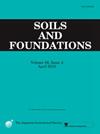Shear wave velocity based prediction of CaCO3 content and UCS in MICP-treated soils with different particle sizes
IF 3.3
2区 工程技术
Q2 ENGINEERING, GEOLOGICAL
引用次数: 0
Abstract
As an emerging soil reinforcement technology, microbial-induced carbonate precipitation (MICP) requires in-situ testing to assess its field performance. Shear wave velocity (Vs) is a viable in-situ method. However, a clear predictive model linking its variations with the CaCO3 content (Cm) and unconfined compressive strength (UCS) of MICP-treated soil—considering particle size as a variable—remains to be established, constraining broader applications of this approach. This study conducts MICP treatment tests on mixtures of excavated soil (silty sand) and surplus sludge (elastic silt), using the mean particle size (d50) as the indicator of particle size. In addition, by varying the sludge proportion (Ps), the impact of particle size on the Vs, Cm, and UCS is examined. During the MICP process, an increase in Ps reduces the increase rate of Cm and Vs. Moreover, Vs stabilizes about 10 h earlier than Cm at a given Ps. This is probably attributed to a shift in CaCO3 precipitation modes from significant strength/stiffness enhancement for soil mixtures to minor contribution. After MICP treatment, Vs, Cm, and UCS decrease linearly with increasing Ps. Following this, Vs-based prediction models for Cm and UCS are respectively developed by considering the particle size. The prediction models are proven to accurately forecast Cm and UCS in MICP-treated soils with different d50 values. This advancement enhances in-situ monitoring techniques that employ Vs to evaluate MICP cementation effectiveness.
基于剪切波速的不同粒径micp处理土壤CaCO3含量和UCS预测
微生物诱导碳酸盐沉淀(MICP)作为一种新兴的土壤加固技术,需要通过现场测试来评估其现场性能。横波速度(Vs)是一种可行的原位方法。然而,将其变化与CaCO3含量(Cm)和micp处理土壤的无侧限抗压强度(UCS)联系起来的明确预测模型(考虑粒径作为变量)仍有待建立,这限制了该方法的更广泛应用。本研究采用平均粒径(d50)作为粒径指标,对开挖土(粉砂)与剩余污泥(弹性粉砂)的混合物进行了MICP处理试验。此外,通过改变污泥比例(Ps),考察了粒径对Vs、Cm和UCS的影响。在MICP过程中,Ps的增加降低了Cm和Vs的增加速率,并且在给定Ps下,Vs比Cm早稳定约10 h。这可能是由于CaCO3降水模式从显著增强土壤混合物的强度/刚度转变为贡献较小。在MICP处理后,Vs、Cm和UCS随Ps的增加而线性降低。在此基础上,考虑粒径,分别建立了基于Vs的Cm和UCS预测模型。结果表明,该预测模型能较准确地预测不同d50值下micp处理土壤的Cm和UCS。这一进步增强了使用v来评估MICP固井效果的原位监测技术。
本文章由计算机程序翻译,如有差异,请以英文原文为准。
求助全文
约1分钟内获得全文
求助全文
来源期刊

Soils and Foundations
工程技术-地球科学综合
CiteScore
6.40
自引率
8.10%
发文量
99
审稿时长
5 months
期刊介绍:
Soils and Foundations is one of the leading journals in the field of soil mechanics and geotechnical engineering. It is the official journal of the Japanese Geotechnical Society (JGS)., The journal publishes a variety of original research paper, technical reports, technical notes, as well as the state-of-the-art reports upon invitation by the Editor, in the fields of soil and rock mechanics, geotechnical engineering, and environmental geotechnics. Since the publication of Volume 1, No.1 issue in June 1960, Soils and Foundations will celebrate the 60th anniversary in the year of 2020.
Soils and Foundations welcomes theoretical as well as practical work associated with the aforementioned field(s). Case studies that describe the original and interdisciplinary work applicable to geotechnical engineering are particularly encouraged. Discussions to each of the published articles are also welcomed in order to provide an avenue in which opinions of peers may be fed back or exchanged. In providing latest expertise on a specific topic, one issue out of six per year on average was allocated to include selected papers from the International Symposia which were held in Japan as well as overseas.
 求助内容:
求助内容: 应助结果提醒方式:
应助结果提醒方式:


